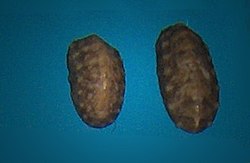| Acanthochitona fascicularis | |
|---|---|
 | |
| Scientific classification | |
| Kingdom: | Animalia |
| Phylum: | Mollusca |
| Class: | Polyplacophora |
| Order: | Chitonida |
| Family: | Acanthochitonidae |
| Genus: | Acanthochitona |
| Species: | A. fascicularis |
| Binomial name | |
| Acanthochitona fascicularis | |
| Synonyms | |
Acanthochitona fascicularis, the Velvety mail shell, [1] is a common chiton in the family Acanthochitonidae.